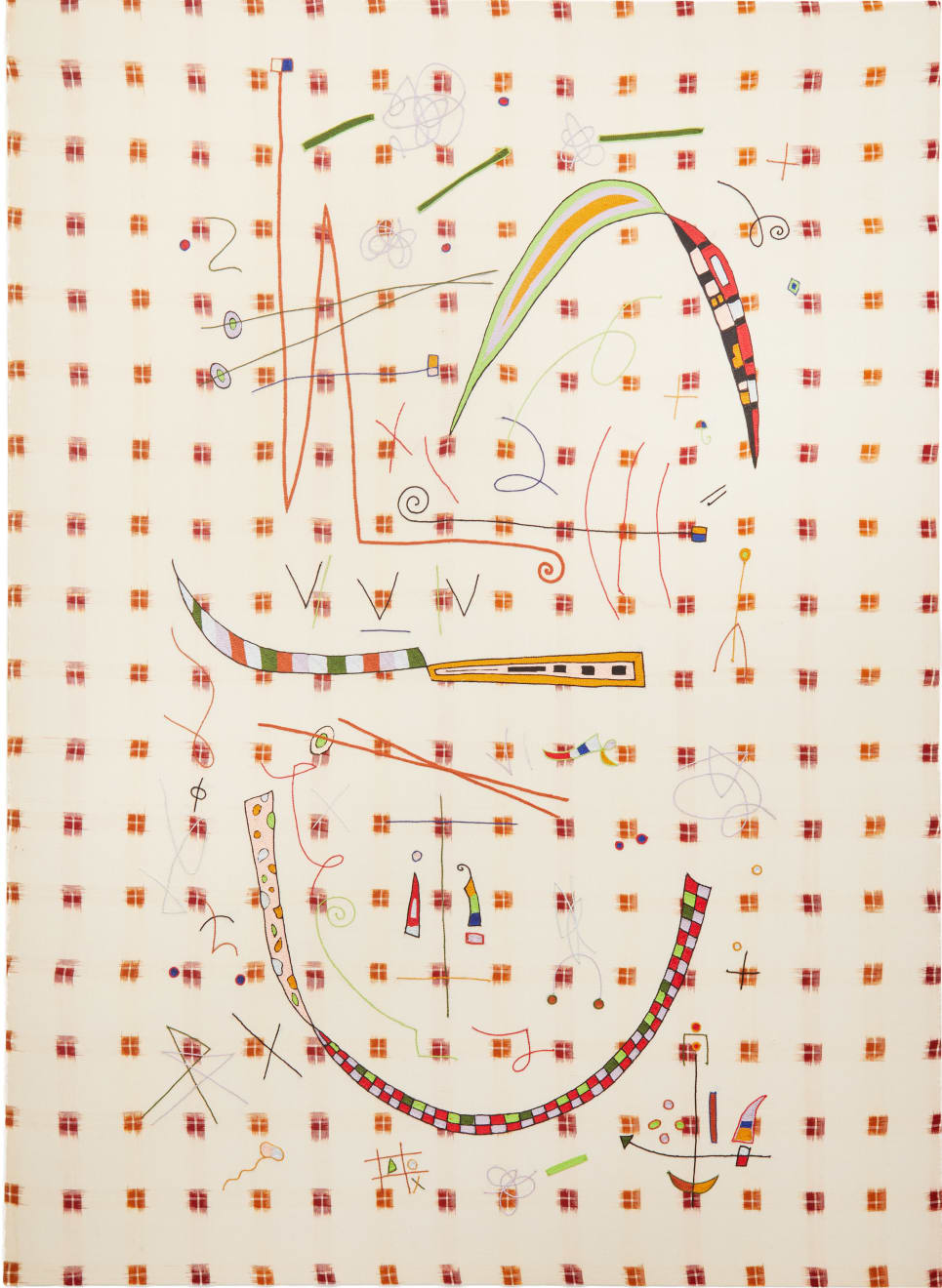Areez Katki b. 1989
Small Vessel/Big Container, 2023
Cotton embroidery on found cloth
(HSN code: 970110)
(HSN code: 970110)
Total: 60.2 x 45.2 inches
Stretched: 53.9 x 39.3 inches
Stretched: 53.9 x 39.3 inches
Copyright Areez Katki, 2023
Exploring the tactile and sensuous nature of textiles has been a recurring focus in Katki’s practice over the past decade. As he gathers and repurposes old, found and sometimes remnants...
Exploring the tactile and sensuous nature of textiles has been a recurring focus in Katki’s practice over the past decade. As he gathers and repurposes old, found and sometimes remnants of newer textiles, we might see how each bolt of cloth holds close associations with material memory, sometimes familial and deeply personal; sometimes more political and historic threads emerge. Though as objects themselves, the use of textiles implies a complex set of politics: while on one hand they speak of industry, culture and the development of manmade crafts, on the other they are intimate substrates that our bodies collide, rub and coalesce with; sometimes textiles are gendered and have associations with domesticity and ritual. While holding all these politics together in his mind, Katki mines the personal and the historic when formulating his embroidered drawings, which puncture and suture alike these surfaces that we view so close to quotidian existences. The stories that we witness in his embroidery often break into abstraction: a style of proto-writing and non-linguistic communication that has become a hallmark of Katki’s visual language.
The recurrence of certain forms, particularly the curved horseshoe, spike or spiral, feature in Katki’s visual lexicon of abstraction in various iterations. Here the U-shaped forms have a planar perspectival rendering in highly polychromatic embroidery, as a way to play with perspective and to think about dimensionality, which Katki later expands upon in his *earth-based works (*which, to no surprise, were formulated around the same months as this panel). In spite of often enjoying the sensuous nature of linear and form-based abstraction as a way to communicate time, memory and place, here we have a title, referring to vessels and containers, which implies a more direct and concrete relation to material culture. Katki produced these works while studying, much as he did with his earth-based works, the phenomenology of Achaemenid and older Persian archaeological fragments of pottery. So, what we have suggested here are no longer vessels and containers but rather their sherds—outlines of their broken handles or lips, in forms and fragments which have refracted in the artist’s imagination and become objects in themselves. Their forms posit questions across material histories about our relationships with the rudimentary geometric, planar and multi-dimensional, that speak of the domestic, the ancient and their enduring affective qualities that relate to the interior in early childhood psychology.
The recurrence of certain forms, particularly the curved horseshoe, spike or spiral, feature in Katki’s visual lexicon of abstraction in various iterations. Here the U-shaped forms have a planar perspectival rendering in highly polychromatic embroidery, as a way to play with perspective and to think about dimensionality, which Katki later expands upon in his *earth-based works (*which, to no surprise, were formulated around the same months as this panel). In spite of often enjoying the sensuous nature of linear and form-based abstraction as a way to communicate time, memory and place, here we have a title, referring to vessels and containers, which implies a more direct and concrete relation to material culture. Katki produced these works while studying, much as he did with his earth-based works, the phenomenology of Achaemenid and older Persian archaeological fragments of pottery. So, what we have suggested here are no longer vessels and containers but rather their sherds—outlines of their broken handles or lips, in forms and fragments which have refracted in the artist’s imagination and become objects in themselves. Their forms posit questions across material histories about our relationships with the rudimentary geometric, planar and multi-dimensional, that speak of the domestic, the ancient and their enduring affective qualities that relate to the interior in early childhood psychology.
1
of
5

